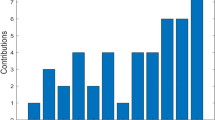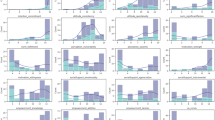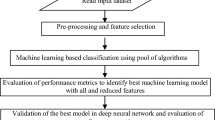Abstract
The exploratory increment in database technology has facilitated researchers and scientist’s throughout the globe to determine best possible knowledge for discovery of hidden patterns and rules among large databases. Unfortunately, several technologies were intervened to measure the hidden patterns but tend to be incompetent, but soft computing techniques solely evaluated the different application domains and its success has potentially driven in prediction of future prognosis. In proposed study we have generalized our approach to discover a combinational model to measure the accuracy among the applicability of the classifiers. A soft computing solutions that we have utilized three different classifiers such as Random Forest, Naïve Bayes and K Nearest Neighbor with pancreatic cancer datasets utilizing varied training test data and ten fold cross validation techniques. Further, varied performance indicators were utilized to measure accuracy among the classifiers which include Area under Curve, F measure, Specificity and others. The Experimental results prove that the proposed approach can benefit end users to discriminate diversified method which can explicitly has potentially higher performance.




Similar content being viewed by others
References
Agrawal A, Misra S, Narayanan R, Polepeddi L, Choudhary A (2011) A lung cancer outcome calculator using ensemble data mining on SEER data, BIOKDD. San Diego
Amit Y, Geman D (1997) Shape quantization and recognition with randomized trees. Neural Comput 9:1545–1588
Bellaachia A, Guven E 2006 predicting breast cancer survivability using data mining techniques. In ninth workshop on mining scientific and engineering datasets in conjunction with the sixth SIAM International Conference on data mining
Breiman L (2001) Random forests. J Mach Learning 45:5–32
Breiman L. (2004). RFtools—for predicting and under-standing data. Technical report. http://www.scirp.org/(S(lz5mqp453edsnp55rrgjct55))/reference/ReferencesPapers.aspx?
Breiman L, Friedman, J, Olshen R, Stone C (1984). Classification and regression trees. Wadsworth International Group, Belmont
Breiman L, Friedman J, Stone CJ, Olshen RA (1993) Classification and regression tree. Chapman & Hall, London
Chang V (2017). Towards data analysis for weather cloud computing. Knowl Based Syst 127:29–45
Chang V, Ramachandran M (2016) towards achieving data security with the cloud computing adoption framework. IEEE Trans Serv Comput 9(1):138–151
Chauhan, R., Kaur, H. (2015a). Big data application in medical domain. In Computational intelligence for big data analysis: Frontier advances and applications, adaptation, learning,and optimization, Vol 19. Springer, Switzerland, pp 165–179
Chauhan, R., Kaur H (2015b). SPAM: An effective and efficient spatial algorithm for mining grid data. Geo-intelligence and visualization through big data trends. IGI Global, 2015, 245–263. Web. 9 Sep. 2015. doi:10.4018/978-1-4666-8465-2.ch010.
Chauhan R, Kaur H, Alam A (2010) Data clustering method for discovering clusters in spatial cancer databases. Int J Comput Appl 10(6):9–14
Delen D, Walker G, Kadam A (2005) Predicting breast cancer survivability: a comparison of three data mining methods. J Arti Intell Med 34(2):113–127
Domingos P, Pazzani M (1997) On the optimality of the simple Bayesian classifier under zero-one loss. Mach Learning 29:103–130
Hand DJ, Till RJ (2001). A simple generalization of the area under the ROC curve to multiple class classification problems. Mach Learning 45(2):171–186.
Hanley JA, McNeil BJ (1982) The meaning and use of the area under a receiver operating characteristic (ROC) curve. Radiology 143:29–36
Hastie T, Tibshirani R, Friedman J (2001) The elements of statistical learning. Springer, Heidelberg. ISBN:9780387848587
Hedberg SR (1995) The data gold rush. Byte 20:83–88
Holsheimer M, Siebes A (1994) Data mining: the search for knowledge in databases. Technical report CS-R9406, CWI, January
Hua W, Qicheng J, Xuegang HU (2008) Application of data mining to medicine. Anhui Med Pharm J 12:746–748
Huang Y, McCullagh PJ, Black N, Harper R (2004) Evaluation of outcome prediction for a clinical diabetes database. In López JA, Benfenati E, Dubitzky W (eds) KELSI 2004, LNCS (LNAI), vol 3303. Springer, Heidelberg, pp 181–190
Kaur H, Tao X (eds) (2014) ICTs and the millennium development goals: a United Nations perspective. Springer, New York
Kaur H, Chauhan R, Wasan SK (2015) A Bayesian network model for probability estimation. In: Mehdi Khosrow-Pour (ed) Encyclopedia of information science and technology, 3rd edn. IGI Global, pp 1551–1558
Kaur H et al (eds) (2017) Catalyzing development through ICT adoption: the developing world experience. Springer, Switzerland
Keles A, Keles A, Yavuz U (2011) Expert system based on neuro-fuzzy rules for diagnosis breast cancer. Exp Syst Appl 38:5719–5726. doi:10.1016/j.eswa.2010.10.061
Lee W, Stolfo SJ, Mok KW (1999a) A data mining framework for building intrusion detection models,” In Proc. of the 1999 IEEE Symp. On Security and Privacy Oakland, CA: IEEE Computer Society Press, San Diego, pp 120–132
Lee W, Stolfo SJ, Mok KW (1999b) Mining in a data-flow environment: Experience in network intrusion detection. In: Chaudhuri S, Madigan D. (eds) Proc. of the fifth international conference on knowledge discovery and data mining (KDD-99). ACM, San Diego, pp 114–124
Massoud T, Lamy JB, Philippe LT (2009) Using data mining techniques to explore physicians’ therapeutic decisions when clinical guidelines do not provide recommendations: methods and example for type 2 diabetes. BMC Med Inform Decis Mak 6:1471–2288
Suzuki (2004). Discovering interesting exception rules with rule pair. Proc. workshop on advances in inductive rule learning at PKDD-2004, 163–178
Tan PN, Kumar V, Srivastava J (2002) Selecting the right interestingness measure for association patterns. Proc. KDD
Tsumoto S (2000). Clinical knowledge discovery in hospital information systems: two case studies. Proc. PKDD-2000, 652–656
Uyar A, Bener A H. Ciray N, Bahceci M (2010) ROC based evaluation and comparison of classifiers for IVF implantation prediction, electronic healthcare. vol. 27, In: Kostkova P (ed) Springer, Berlin Heidelberg, 108–111
Warner JH, Liang Q, Sarkar M (2010) Adaptive regression modeling of biomarkrs of potential harm in a population of US adult cigarette smokers and nonsmokers. BMC Med Res Method 1–10:19
Wasan SK, Bhatnagar V, Kaur H (2006) The impact of data mining techniques on medical diagnostics. Data Sci J 5:119–126
Weiss SH, Indurkhya N (1998) Predictive data mining: a practical guide. Morgan Kaufmann Publishers, San Francisco
Wong ML, Leung KS (2000) Data mining using grammar based genetic programming and applications. Kluwer, Norwell
Wu X, Gong-Quing Wu, Ding W (2014) Data mining with big data. IEEE Trans Knowl Data Eng 26(1):97–107
Yingjie L, Yisheng Z, Yuhong X (2001) The nonlinear dynamical analysis of the EEG in schizophrenia with temporal and spatial embedding dimension. J Med Eng Technol 25:79–83
Acknowledgements
This research work is catalyzed and supported by National Council for Science and Technology Communications (NCSTC), Department of Science and Technology (DST), Ministry of Science and Technology (Govt. of India) for support and motivation [Grant Recipient: Dr. Harleen Kaur]. The authors gratefully acknowledge financial support from the Ministry of Science and Technology (Govt. of India), India.
Author information
Authors and Affiliations
Corresponding author
Rights and permissions
About this article
Cite this article
Chauhan, R., Kaur, H. & Chang, V. Advancement and applicability of classifiers for variant exponential model to optimize the accuracy for deep learning. J Ambient Intell Human Comput (2017). https://doi.org/10.1007/s12652-017-0561-x
Received:
Accepted:
Published:
DOI: https://doi.org/10.1007/s12652-017-0561-x




